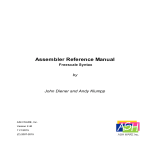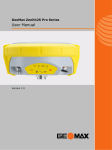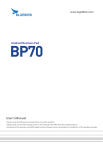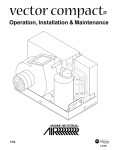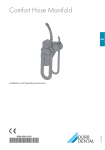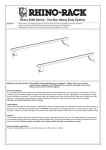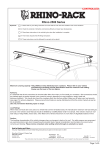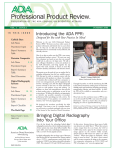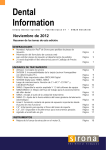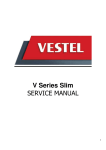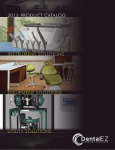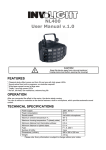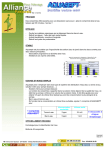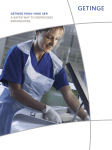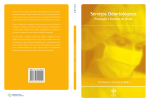Download ADA Professional Product Review
Transcript
Volume 9 • Issue 2 2014 A Publication of the Council on Scientific Affairs In This Issue: Unbiased. Scientifically Sound. Clinically Relevant. User-Friendly. Editor David C. Sarrett, DMD, MS Chair, ADA Council on Scientific Affairs Edmond L. Truelove, DDS Senior VP, Science/ Professional Affairs Daniel M. Meyer, DDS Sr. Director, Center for Scientific Strategies & Information Eugenio Beltrán, DMD, DrPH Manager, Laboratory Operations Jamie Spomer, PhD Program Manager Nina A. Koziol Letters to the Editor, Reprints and Permissions ppreditor@ada.org, 312.440.2840 Internet ada.org/ppr ©2014. American Dental Association. All rights reserved. Letter from the Editor - David C. Sarrett, DMD, MS All good publications do routine evaluations to determine how to best serve their readers, and the ADA Professional Product Review is no exception. Feedback comes to me from many sources—fellow faculty and deans, dental students and others. And, we routinely survey groups of ADA members to get input about topics the newsletter should pursue. Based on that feedback, we are expanding our content to provide a variety of information on dental equipment, materials, occupational safety and health issues and other areas that affect your daily practice. For this issue, we interviewed Dr. Shannon Mills and Dr. John Tullner for the article, “Surface Disinfectants: What dentists and their staff need to know.” Disinfectant products have been around for decades, but you may be surprised to hear what they have to say about contact time and efficacy. In a new feature, Mailbox, we’ll be answering some of the many questions that ADA members pose to the ADA’s Division of Science, such as “Must I bag all instruments? What if I use them as soon as they have been autoclaved? Can I bag instruments after sterilization? Can I wear a short sleeve lab jacket when it’s hot?” The ADA Laboratory also did two evaluations for this issue—one on dental unit water treatment systems and one on temperature rise in electric handpieces, which can produce burns. And, if you’re thinking of buying or updating your electronic health records system, you’ll want to read the article by Mike Uretz that looks at things to consider before moving forward. I’d like to hear from you. What topics would you like to see covered in future issues? Contact me at ppreditor@ada.org. Surface Disinfectants: What dentists and their staff need to know 2 Information at your fingertips 6 Disease Transmission Through Dental Unit Water: An Update 8 A Laboratory Evaluation of Dental Unit Water Treatment Systems 9 A Laboratory Evaluation of Electric Handpiece Temperature and the Associated Risk of Burns 18 Dental Electronic Health Records Systems: General Considerations Before You Buy 25 Mailbox 30 211 East Chicago Avenue Chicago, Illinois 60611-2678 ISSN 1930-8736 PPR_VOL_9_ISS_2_2014_r1.indd 1 5/12/14 3:54 PM Surface Disinfectants: What dentists and their staff need to know Shannon E. Mills, DDS Dr. Mills is vice president, professional relations and science at Northeast Delta Dental in Concord, New Hampshire. He is a graduate of Baylor College of Dentistry and served as a dental officer in the U.S. Air Force in the United States and overseas. He served as an Associate Professor in the Dental General Practice Residency at the University of Nevada School of Dental Medicine in Las Vegas. He is recognized internationally as an expert on infection control and safety in dentistry and has authored and co-authored several peer-reviewed scientific papers, review articles and research abstracts. He was a contributor to the 2003 Centers for Disease Control and Prevention Guidelines for Infection Control in Healthcare Settings. He has served as chair of the American National Standards Institute/American Dental Association (ADA) Standards Committee for Dental Products and the Organization for Safety, Asepsis and Prevention (OSAP). He served as a consultant to the ADA Council on Scientific Affairs and is a peer reviewer for the Journal of the American Dental Association. E ach year at the ADA’s annual dental meeting, the ADA Professional Product Review hosts a CE program called the Product Forum, which allows dentists to learn about product selection and evaluations. In 2012, the Product Forum focused on infection control products, including surface disinfectants. Two infection control experts, Dr. Shannon Mills and Dr. John Tullner, were on hand to answer participants’ questions. In this issue, the ADA Professional Product Review’s editor Dr. David Sarrett poses questions to Drs. Mills and Tullner about the use of surface disinfectants in the dental office. ADA Professional Product Review Dr. David Sarrett: How effective are surface disinfectants and what do dentists need to know about their proper use? Dr. Shannon Mills: When used as directed, disinfectants should make it unlikely for disease transmission to occur because of contact with contaminated housekeeping or contact surfaces in the dental treatment area. In order for a disinfectant to work however, the surfaces must first be cleaned to remove any organic soil including blood and saliva. DS: What types of organisms do these products kill? Dr. John Tullner: It depends on the level of the disinfectant, for example, whether it is intermediate 2 PPR_VOL_9_ISS_2_2014_r1.indd 2 John B. Tullner, DDS Dr. Tullner is a graduate of the Baltimore College of Dental Surgery (now the University of Maryland School of Dentistry) and served three years in the U.S. Army Dental Corps as a general practice resident and staff dentist. He served as the consultant for dental infection control to the VA Headquarters Office of Dentistry prior to his retirement as Chief of the Dental Service at the VA Medical Center, Richmond, Virginia, with over 28 years of VA service. Most recently, he was an Adjunct Assistant Professor at the Virginia Commonwealth University School of Dentistry where he coordinated the Infection Control and OSHA programs. Dr. Tullner has lectured nationally and internationally on the practical application of dental infection control and the OSHA Bloodborne Pathogens Standard. He is a Fellow of the International College of Dentists and is a member of the American Dental Association, American Dental Education Association and the Organization for Safety, Asepsis and Prevention (OSAP). or low-level. EPA-approved intermediate-level disinfectants kill Mycobacterium tuberculosis var. bovis, a very resistant organism but not a human pathogen, as well as, but not limited to, fungi such as candida, Rhinovirus, Coxsackie and Polio viruses, bacteria such as staphylococcus, pseudomonas and salmonella species, and viruses such as HIV, HSV, and Hepatitis B and C. Low-level (hospital grade) disinfectants have a more limited spectrum but are also effective against staphylococcus, pseudomonas and salmonella species as well as HIV, HSV, and Hepatitis B and C. I highly recommend that dentists refer to the chart on page 64 (in Appendix A) of the CDC Guidelines for Infection Control in Dental Health-Care Settings—2003. SM: To know which organisms are killed, you again have to read the label. Intermediate-level “hospital” disinfectants are often used on surfaces that are routinely touched during patient care. To be considered an intermediate hospital disinfectant, the product must be able to kill certain specific bacterial species including Mycobacterium tuberculosis. This organism is considered the benchmark for this class of disinfectants because it represents a type of bacterium that is resistant to many kinds of chemical disinfectants, not because it is transmitted from environmental surfaces. The label specifically lists viruses and other organisms that the Continued on next page 5/12/14 3:54 PM Continued from previous page “One of the most common questions I get asked is ‘How long should I leave surface cleaners on?’ It’s simple stuff but overlooked. People need to read the instructions.” —A dentist visiting the ADA Professional Product Review’s 2012 Product Forum germicide has been tested against. These usually include both lipid and non-lipid viruses and representative fungi. Any disinfectant that is tuberculocidal will generally kill other viruses, bacteria or fungi, but will not inactivate bacterial spores. (if not ready to use), organism kill claims, safety information, contact times, cleaning ability, and compatibility with materials and surfaces are some examples of characteristics that can vary significantly between disinfectant products. Low-level disinfectants do not have to be tuberculocidal, and can be used on housekeeping surfaces that are not contacted during procedures. SM: Another important first step is seeing [noting] the kill time for Mycobacterium tuberculosis for intermediate-level “hospital” disinfectants, which is sometimes highlighted in the manufacturer’s promotional materials, but the user may not realize that the overall contact time is longer. Adding alcohol to a product can reduce TB kill times, but not affect the kill time for other bacteria, viruses and fungi. Read the whole label and the directions for use before buying or using a product. Keep in mind also, that M. tuberculosis is included in label claims because it represents an organism that is resistant to many kinds of disinfectants, not because it represents a significant hazard to staff or patients on environmental surfaces. JT: No! Never use high-level disinfectant chemicals for surface disinfection. Improper use of these products is in violation of Federal Law. See the label and package insert. DS: Why should dentists be concerned about whether or not their disinfectant kills TB? JT: We should be concerned because Mycobacterium tuberculosis var. bovis is a very resistant organism that is hard to kill and, as such, is considered the “benchmark” organism for intermediate-level disinfectants. If you refer to the CDC Guidelines for Infection Control in Dental Health-Care Settings—2003, you’ll see that intermediate-level disinfectants kill all of the pathogens we are most concerned about in dentistry but they do not kill spore formers. DS: What’s the first step in the proper use of surface disinfectants? JT: I feel the first step is reading the label instructions carefully. Directions for proper use, dilution factors PPR_VOL_9_ISS_2_2014_r1.indd 3 DS: Are all surface disinfectants alike? JT: Surface disinfectants are not alike. They have varied chemical classifications each having pros and cons. For instance, while dilute sodium hypochlorite is an effective intermediate level disinfectant, it can corrode certain metals. Some surface disinfectants may be better cleaners—containing surfactants—than others. A surface disinfectant that is also a good cleaner may help limit the number of products needed for surface disinfection in a dental practice. SM: No, they’re not all alike. The effectiveness, cleaning ability, toxicity and compatibility with the surfaces to be disinfected varies widely among products. Bleach for example, is highly effective against a broad range of organisms and is non-toxic. It is, however, caustic at high concentrations, corrosive to metals and can damage many other materials used in the manufacture of dental devices. Shelf life (how long the product is effective when stored unopened) and use life (how long a product is effective after being dispensed, diluted or activated), Continued on next page 3 Volume 9• Issue 2 DS: Can high-level disinfectants, such as those that contain glutaraldehyde, be used for surface disinfection? 2014 In addition to tuberculocidal activity, high-level disinfectants can inactivate bacterial spores with sufficient contact time. They are not considered surface disinfectants and are used for high-level immersion disinfection or sterilization of instruments and other items that contact or penetrate skin or mucous membranes that cannot withstand sterilization with heat. 5/12/14 3:54 PM Continued from previous page and requirements for disposal also vary among products. These considerations are all important when choosing the right disinfectant. DS: How do you know a product is ok to use? SM: A product that has an EPA Registration has been approved for use as a disinfectant in the United States and is safe when used according to the manufacturer’s directions for use. These directions may include use of personal protective equipment or proper ventilation of spaces where the disinfectant is used. Consult the product’s Safety Data Sheet for complete information. JT: First, one needs to decide on the purpose the product is to be used for. If the product is to be used for contaminated clinic housekeeping surfaces such as sinks, walls or floors, an EPA-registered hospital (low-level) detergent disinfectant is recommended, or in some cases where there is minimal contamination, a good detergent with water would suffice. In the case of high touch (clinical contact) environmental surfaces in the dental clinic, if the surface is visibly contaminated with Table 1. Methods for Sterilizing and Disinfecting Patient-Care Items and Environmental Surfaces* APPLICATION PROCESS DEFINITION METHOD Sterilization EXAMPLE Patient-Care Items High Steam, dry heat, unsaturated chemical vapor Heat tolerant critical and semicritical Low Ethylene oxide gas, plasma sterilization Heat tolerant or heat sensitive critical and semicritical Glutaraldehyde, glutaraldehydes with phenols, hydrogen peroxide, hydrogen peroxide with peracetic acid, peracetic acid Heat sensitive critical or semicritical Heat Destroys all microorganisms, including bacterial spores Liquid immersion High-level disinfection Heat Destroys all microorganisms, but not necessarily high numbers of bacterial spores Intermediatelevel disinfection Liquid immersion Destroys vegetative bacteria, most fungi, and most viruses; does inactivate Mycobacterium tuberculosis var. bovis‡ Not necessarily capable of killing bacterial spores Low-level disinfection Liquid ADA Professional Product Review Destroys most vegetative bacteria, some fungi, and some viruses. Does not inactivate Mycobacterium tuberculosis var. bovis Environmental Surfaces Not applicable Washer disinfector Glutaraldehyde, glutaraldehydes with phenols, hydrogen peroxide, hydrogen peroxide with peracetic acid, ortho-phthalaldehyde Heat-sensitive semicritical EPA-registered hospital disinfectant with label claim of tuberculocidal activity (e.g. chlorine-containing products, quaternary ammonium compounds with alcohol, phenolics, bromides, iodophors, EPA-registered chlorine-based product) Noncritical with visible blood Clinical contact surfaces Blood spills on housekeeping surfaces EPA-registered hospital disinfectant with no label claim regarding tuberculocidal activity OSHA also requires label claim of HIV and HBV potency for use of low-level disinfectant for use on clinical contact surfaces Noncritical without visible blood Clinical contact surfaces Housekeeping surfaces (e.g. quaternary ammonium compounds, some phenolics, some iodophors) The U.S. Environmental Protection Agency (EPA) and the U.S. Food and Drug Administration (FDA) regulate chemical germicides used in health care settings.The FDA regulates chemical sterilants used on critical and semicritical medical devices, and the EPA regulates gaseous sterilants and liquid chemical disinfectants used on noncritical surfaces. FDA also regulates medical devices, including sterilizers. ‡ Inactivation of the more resistant Mycobacterium tuberculosis var. bovis is used as a benchmark to measure germicidal potency. * CDC. Guidelines for infection control in dental health care settings–2003. MMWR2003;52(No.RR-17):1–66. 4 PPR_VOL_9_ISS_2_2014_r1.indd 4 Continued on next page 5/12/14 3:54 PM Continued from previous page blood or saliva, an EPA-registered intermediate level disinfectant should be used. When there is no visible contamination (bioburden), a low-level disinfectant should suffice. It’s always important to remember that proper pre-cleaning of all environmental surfaces or equipment is of major importance prior to disinfection. DS: What’s the difference between one- and twostep surface disinfectants? SM: A one-step product is effective as both a cleaner and disinfectant. Some types of germicides are also detergents or contain surfactants that help remove organic soil. Some products, particularly those with high alcohol content can actually impede the removal of organic soil and require pre-cleaning with a detergent to be fully effective. These types of products are often referred to as two-step disinfectants. Using a one-step disinfectant does not mean that the cleaning step can be skipped when surfaces are contaminated. DS: Do surfaces need to be “pre-cleaned” before you use a surface disinfectant? JT: Absolutely. I learned early on from Dr. Jim Crawford [a pioneering and pivotal figure in dental infection control] and others that pre-cleaning is a critical part of the disinfection process. All visible bioburden should be removed for disinfectants to properly do their job. DS: What about formulations? You mentioned that manufacturers may keep brand names but change their formulas? Do dentists need to be concerned about that? JT: In some cases, manufacturers market two products with similar names, but they may have a different chemical formulation/disinfectant. An example is Clorox Disinfecting Wipes (an alcohol/dual quaternary ammonium product) and Clorox Bleach Germicidal Wipes (a sodium hypochlorite bleach product). Both are EPA-registered disinfectants but they have different chemical formulations. I believe that many people think of Clorox as bleach so this can be confusing if dentists and their staff do not carefully read the label. DS: How long should you leave a surface disinfectant on? JT: Times vary for each product, generally between one and 10 minutes. I can’t stress enough how important it is to read the product label for proper use. Also, make sure you use enough disinfectant so that it does not evaporate in less than the required contact time. DS: What other considerations should you watch out for? JT: Check the shelf-life and reuse-life of the product as well as the expiration date. Also, make sure if the product needs to be diluted and follow the manufacturer’s instructions. Do not mix additional products or add soap to a disinfectant. That practice can inactivate the chemical disinfectant and can also be dangerous. Table 2. Decreasing order of resistance of microorganisms to germicidal chemicals ORGANISM PROCESSING LEVEL REQUIRED FOR STERILIZATION Bacterial spores Geobacillus stearothermophilus Bacillus atrophaeus FDA sterilant/high-level disinfectant (=CDC sterilant/high-level disinfectant) Mycobacteria Myobacterium tuberculosis Nonlipid or small viruses Polio virus Coxsackie virus Rhinovirus EPA hospital disinfectant with tuberculocidal claim (=CDC intermediate-level disinfectant) Fungi Aspergillus Candida Vegetative bacteria EPA hospital disinfectant (=CDC low-level disinfectant) Human immunodeficiency virus Herpes simplex virus Hepatitis B and hepatitis C Coronavirus Source: Adapted from Bond WW, Ott BJ, Franke K, McCracken JE. Effective use of liquid chemical germicides on medical devices; instrument design problems. In: Block SS ed. Disinfection, sterilization and preservation. 4th ed. Philadelphia, PA: Lea & Febiger, 1991:1100. Continued on next page PPR_VOL_9_ISS_2_2014_r1.indd 5 2014 Lipid or medium-sized viruses Volume 9• Issue 2 Staphylococcus species Pseudomonas species Salmonella species 5 5/12/14 3:54 PM Continued from previous page SM: To avoid corrosion, discoloration or other damage to surfaces on dental equipment, including chairs, units and accessories, which may be caused by disinfectants, contact the equipment manufacturer for its recommendations. You may also find this information in your user manual. Always use the products as directed, especially in regards to contact time and personal protective equipment. appropriate clothing. If you have disinfectant-equipment compatibility questions, it’s best to contact the manufacturer for advice. This can avoid costly damage. Have a blood spill kit available for pre-cleaning prior to disinfection of large spills. DS: Anything else you’d like to add? JT: It’s not important to get brand names, it’s important to know the concepts and how to choose a product. And, be sure to have all users wear appropriate personal protective equipment such as gloves, eye protection and SM: While disinfectants are important adjuncts to infection control practice, they can damage surfaces and may pose risk for personnel. To reduce use of disinfectants, consider the use of single use disposable barriers where practical. You can find more information on infection control at ADA.org. ADA Professional Product Review Information at your fingertips If you’re an ADA member, you have full-text access to more than 280 journals through the ADA’s Library & Archives website. Of these online journals, 95 percent are dental-related and the rest have a medical-dental crossover. Most articles in the collection were published in the past five years. However, some publishers allow access to older articles. Members can search for articles through EbscoHost and the ADA reference librarians can help members who don’t have experience searching databases. Due to some license restrictions, members would need to contact the Library to access some premium websites such as Wiley Online, Science Direct and Quintessence Publications. Members can view tables of contents and article abstracts from these premium sites, and Library staff can immediately send PDF copies of the article via email. Visit the ADA Library & Archives website— it’s information at your fingertips. 6 PPR_VOL_9_ISS_2_2014_r1.indd 6 5/12/14 3:54 PM PPR_VOL_9_ISS_2_2014_r1.indd 7 5/12/14 3:54 PM Disease Transmission Through Dental Unit Water: An Update Stephen E. Gruninger F or the past 20 years, standard precautions have included a recommendation intended to limit dental unit water microbial contamination. It is inconsistent to ignore dental unit water quality, while strictly adhering to the use of personal protective equipment, immunizations, surface disinfection, sterilization of instruments, biohazard waste handling, avoidance of percutaneous injuries, and appropriate use of disposable supplies.1 Intuitively, keeping microbial numbers as low as possible is logical. But where is the evidence that disease is transmitted by contaminated dental unit water to patient or provider? We have some insight to that question in a 2012 case report in The Lancet.2 The report described an elderly woman in Italy who acquired Legionella pneumophila infection after two visits to her dentist and subsequently died. Legionella pneumophila, subtype 1, was found in both the patient and in the dentist’s high-speed handpiece waterline. Measured microbial numbers in the waterline were 62,000 CFU/mL, more than 120 times higher than the current CDC and ADA recommendation of 500 CFU/mL.1 Many studies have shown that different species of legionella can be identified in dental unit water, but this was the first documented Legionella pneumophila fatality related to dental unit water. ADA Professional Product Review You might speculate that if L. pneumophila can be in dental unit water, then dentists could acquire Legionella pneumophila occupationally. The ADA Health Screening Program (HSP), held at various cities during the ADA’s annual convention, began looking at this issue about 10 years ago, ending in 2012. HSP participants’ blood was assayed for the presence of L. pneumophila antibodies, subgroups 1-6. The results were surprising. L. pneumophila antibody prevalence among these dentists ranged from a low of 4.6% at the HSP held in Honolulu to a high of 22% at the HSP held in Philadelphia. The average prevalence over 10 years was about 11%. This is much higher than the current dentist antibody prevalence for the bloodborne pathogens, HBV, HCV and HIV. However, a small control group of non-dentists surveyed at the same time showed approximately the same prevalence as dentists.3 Although L. pneumophila antibody prevalence was high, evidence for occupational exposure was not strong. Further analyses showed that exposure is unrelated to how often dentists monitored the microbial numbers in their dental unit waterlines, or whether or not they reported cleaning their waterlines by one or more methods. However, L. pneumophila exposure was strongly correlated with where a dentist lived. Furthermore, Legionella pneumophila antibody prevalence did not differ significantly between multiple visits to the same HSP location separated by at least four years. This fact gives additional support to a geographical bias for the observed L. pneumophila antibody prevalence among locations across the United States.4 So what does this tell us? If we accept that L. pneumophila is ubiquitous throughout the environment, then dentists can come into contact with the bacterium like any other non-dentist. The source of exposure could be from a home shower head or water faucet, public drinking fountains, garden hoses or any other source where a fine spray or mist of warm water could be inhaled or otherwise aspirated. Of course, the source could also be from untreated dental unit water. While L. pneumophila in dental unit water may not be a significant source of disease transmission, the Italian case report certainly shows that transmission can occur, especially in elderly and other immunocompromised patients. Furthermore, there are a multitude of microbes, some pathogenic, capable of forming biofilms in dental unit water. Many of these microbes can present an infectious hazard in immunocompromised patients. Good infection control practices demand that dental unit water be as free from infectious contaminants as possible. References 1. Centers for Disease Control and Prevention. Recommendations and Reports. Guidelines for Infection Control in Dental Health-Care Settings—2003; MMWR Recomm Rep: 2003 Dec 19;52 (RR-17):1-61. http://www.ada.org/sections/professionalResources/pdfs/guidelines_cdc_infection.pdf. Accessed March 25, 2014 2. Ricci ML, Fontana, S, Pinci, F, Fiumana E, Pedna MF, Farolfi P, Sabattini, MA, Scaturro, M. Pneumonia associated with a dental unit waterline. Rome Italy: Department of Infectious Parasitic and Immune-Mediated Diseases, Istituto Superiore di Sanità; Lancet 2012; 379:684. http://www.thelancet.com/journals/ lancet/article/PIIS0140-6736(12)60074-9/fulltext#article_upsell. Accessed March 25, 2014 3. Vogt KL, Gruninger SE, Kang P, Siew C, Meyer DM. Occupational exposure to Legionella among dentists. J Dental Res. March 9-12, 2005;84(Special Issue A). https://iadr.confex.com/iadr/2005Balt/print/abstractbook8.html. Accessed March 25, 2014. 4. CG Estrich, KL Vogt, SE Gruninger. 2014. Dental Practioners’ Risk Factors for Exposure to Legionella pneumophila. J Dental Res. March 19-22, 2014;93 (Special Issue A): https://iadr.confex.com/iadr/43am/webprogram/Paper186560.html. Accessed March 25, 2014. 8 PPR_VOL_9_ISS_2_2014_r1.indd 8 5/12/14 3:54 PM A Laboratory Evaluation of Dental Unit Water Treatment Systems Disinfecting dental unit waterlines can be challenging because the tubing is not easily accessible. Measures to control build-up of biofilm in the tubing typically focus on the treatment of incoming water, or the introduction of chemical disinfectants via a reservoir While the initial investment for devices that treat incoming water is greater at the outset (Table 1), less expensive chemical disinfectants present more opportunities for human error, such as neglecting to apply a chemical treatment according to schedule. (See Cost Considerations on page 10 for more information about cost.) The ADA Laboratory staff purchased and evaluated eight dental unit waterline treatment devices and one independent sterilizable water delivery system to determine which products deliver water that meets the EPA standard for potable water. The devices evaluated here do not remove established biofilm, and therefore are intended for use in either brand new installations, or existing dental unit waterlines that have been treated to remove biofilm. These devices treat water before it enters the unit to prevent the introduction of microbes and eventual establishment of biofilm. Routine chemical treatment of the waterlines is not required by the manufacturer when one of these devices is used. We also evaluated one portable dental unit with reservoir bottles and sterilizable tubing (AquaSept Heat Sterilizable Independent Water Delivery System; AquaSept, Hudson, Wis.). In addition to providing information on the efficacy of these products, it is our goal to address practical issues especially since the initial investment in these products may be substantial. Volume 9• Issue 2 Dental unit waterlines are considered an ideal substrate for biofilms, which thrive in an aqueous environment characterized by frequent periods of stagnation. The small volume of water that passes through tubing with a relatively large surface area (interior tubing diameter is typically 1.5 - 2 mm) creates a large volume-tosurface area ratio, where decreased laminar flow at the tubing wall increases the potential for biofilm formation. If left unmanaged, organisms can proliferate to several hundred times their original concentration. Minerals from tap water deposit onto the tubing wall and become attachment sites for bacteria. Dead bacteria and other organic matter reinforce bacterial growth on the interior tubing wall, forming a dense, protective matrix that hinders biofilm removal. The matrix encourages biofilm maturation and thickening, narrows the tubing channel, restricts water flow, and provides the foundation for rapid microbial re-colonization when only disinfecting methods are used for control.3 bottle before delivery to the patient. Treatment of incoming water from the main municipal supply at the operatory level can be accomplished by water purification, ozone treatment, ultraviolet radiation, and/or filtration methods, which can be expensive, but generally require less frequent maintenance than the intermittent or continuous use of chemical disinfectants, which are relatively inexpensive and seemingly straightforward. While the cost of chemical treatments can be just pennies per use, these products must be delivered according to a set schedule to be effective. Maintenance solutions are placed in the reservoir bottle each time it is filled, followed by the delivery of shock solutions on a weekly or monthly basis, according to the manufacturer’s instructions. 2014 T he U.S. Environmental Protection Agency’s (EPA) Safe Drinking Water Act allows a maximum limit of 500 colony forming units per milliliter (CFU/mL) heterotrophic bacteria.1 However, it is not uncommon for water from dental units to contain as much as 100,000 CFU/mL, greatly exceeding the maximum allowed for potable water.2-4 The U.S. Centers for Disease Control and Prevention’s Guidelines for Infection Control in Dental Health-Care Settings recommend that water exiting the dental unit (treated water) has no more than 500 CFU/mL bacteria, which reflects the EPA’s maximum safe level of heterotrophic bacteria in drinking water.5,6 The American Dental Association’s Council on Scientific Affairs’ “Statement on Dental Unit Waterlines,” updated in 2012, notes that “dental unit waterlines must be maintained regularly to deliver water of an optimal microbiologic quality.” Thus, every dental office infection control plan should include a process for maintaining dental unit water quality.6 Continued on next page PPR_VOL_9_ISS_2_2014_r1.indd 9 9 5/12/14 3:54 PM Continued from previous page Table 1. Product Features, According to Manufacturer. Device Name and Manufacturer AquaSept Heat Sterilizable Independent Water Delivery System (Cart) AQUASEPT LLC Hudson, WI 888-539-3907 www.Aquasept.com Dimensions Control box: 12" W x 4" H x 3" D Cart: 20" W x 29" H x 10" D (extends to 40" H) Cost Considerations $3,307.00 for cart, one handpiece line (excludes handpiece) and one syringe line§ DentaPure DP365B Dental Unit Water Purification Cartridge MRLB INTERNATIONAL, INC. Fergus Falls, MN 800-972-3543 www.dentapure.com 6 ¾" H x 3/4" D $249.95 Sterisil Straw for Municipal Water (S365M) STERISIL, INC. Palmer Lake, CO (719) 622-7200 www.sterisil.com 6.5" H x 0.625" D $150.00 Sterisil Straw for Distilled Water (S365) STERISIL, INC. Palmer Lake, CO (719) 622-7200 www.sterisil.com 6.5" H x 0.625" D $150.00 DentaPure DP365M Dental Unit Water Purification Cartridge MRLB INTERNATIONAL, INC. Fergus Falls, MN 800-972-3543 www.dentapure.com 6 ¾" H x 2 1/4" D $249.95 ADA Professional Product Review CV-SK installation kit for $64.00 CV-20 (source water >150 ppm) $160.00 Sterisil Cartridge* STERISIL, INC. Palmer Lake, CO (719) 622-7200 www.sterisil.com 15.5" H x 2.5" D Sterisil System STERISIL, INC. Palmer Lake, CO (719) 622-7200 www.sterisil.com 17.5" W x 17" H x 6.5" D $5,275.00 VistaClear 1000 VISTA RESEARCH GROUP, LLC Ashland, OH (Distributed by Pelton & Crane) 800-659-6560 www.VistaResearchGroup.com 8" W x 10" H x 5" D VistaClear 1000 has been discontinued and is replaced by multi-chair VistaClear 2000 Model, which retails for $5,999.00 The mode of operation is identical for both models. Waterclave Water Purifier Model WCJ64-40 WATERCLAVE, LLC Overland Park, KS (913) 312-5860 www.Waterclave.com 18" W x 20" H x 27" D $10,995.00 CV-10 (source water 76-150 ppm) $130.00 CV-8 (source water 0-75 ppm) $110.00 The manufacturer’s suggested retail price is as of February 2014. Actual price may vary. § Price includes cart, one handpiece line and one syringe line. Must purchase additional handpiece and syringe lines to accommodate procedure load between autoclave cycles. Cost of each additional handpiece and syringe line is $695.00. * The in-line cartridge fits in the junction (floor) box of the dental unit, while the valved cartridge is cabinet-mounted. Appropriate model is based on Total Dissolved Solids (TDS) measurement of your office tap water using a TDS-3 Handheld meter (Sterisil, Inc.). The CV-20 Model was recommended by Sterisil based on TDS level of source water used in this evaluation (~300 ppm). Contact Sterisil to select the right cartridge based on the TDS level of your water. 10 PPR_VOL_9_ISS_2_2014_r1.indd 10 Continued on next page 5/12/14 3:54 PM Continued from previous page Water Treatment Device AquaSept Heat Sterilizable Independent Water Delivery System DentaPure DP365B Purification Cartridge Sterisil Straw for Distilled Water (S365) Sterisil Straw for Municipal Water (S365M) DentaPure DP365M Purification Cartridge Sterisil Cartridge Sterisil System VistaClear Waterclave Water Purifier Intended Use Delivers sterile water for dental procedures Replaces pick up straw in reservoir bottle; treats bottled source water Replaces pick up straw in reservoir bottle; treats bottled water <100 ppm TDS Replaces pick up straw in reservoir bottle; treats municipal tap water >100 ppm TDS Treats municipal tap water Treats municipal tap water Centralized system supplies water for 1-100 dental units Treats municipal tap water Supplies sterile water to up to 60 dental units Mode of Action/Active Ingredient(s) Reservoir bottles, control heads and tubing are sterilized in a steam autoclave after each patient Continuously elutes 2-6 ppm iodine into treatment water Releases antimicrobial (silver) into treatment water Releases antimicrobial (silver) into treatment water Continuously elutes 2-6 ppm iodine into treatment water Removes TDS and releases antimicrobial (silver) into treatment water Filters particulates, removes ions and organics, and disinfects deionized water with UV irradiation and silver Physical filtering process and chemical reaction imparting a bacteriostatic effect Heats water to 188°F 190°F with pressure Recommended Operating Air Pressure 60 psi 45 psi 40 psi 40 psi 45 psi 45 psi 75 psi 40 psi 20-90 psi Recommended Flow Rate Not specified Not specified 25 mL/min 25 mL/min Not specified 25 mL/min 100 mL/ min 0.76 L/min 0.20 gallons/ min Not specified Capacity (volume of water) N/A 240 L 240 L 240 L 240 L Varies; depends on TDS in water 1,000 L per year € 567 L Purifies 15 gallons per hour Indicator Threshold N/A Iodine must be > 0.5 ppm N/A N/A Iodine must be > 0.5 ppm TDS must remain below 10 ppm TDS must remain below 10 ppm N/A N/A Recommended Shock Treatment N/A Not specified Built-in shock treatment Built-in shock treatment Not specified Built-in shock treatment Citrisil by Sterisil, Inc. VistaTab for initial shock Sterilex Ultra Liquid by Sterilex Corp. Power Requirements None None None None None None Must be installed near an electrical outlet None Must install near electrical source having appropriate voltage (208 or 240 V) Audible/ Visible Alarm No No No No No No Yes No Yes Ongoing Maintenance Costs None No No No No Multiple cartridges per year $ 1,052 for filter replacement cost VistaClean cleaning solution None Installation Service Available Yes, via phone No No No Yes Yes Yes Yes Yes Replacement Parts and Accessories 16 oz. bottles, or adapters various size sterilized water bottles; sterilization cassette Iodine test strips sold separately N/A N/A Iodine test strips sold separately N/A N/A N/A Reverse osmosis filters, chemical shock accessories, etc. Volume 9• Issue 2 Table 2. Product Features 2014 Systems are available that will treat 3,000, 7,000, and 10,000 liters of water annually. This information was collected from the manufacturers’ directions for use, product packaging and information the manufacturer submitted on the ADA Laboratory’s technical product table form. Continued on next page PPR_VOL_9_ISS_2_2014_r1.indd 11 11 5/12/14 3:54 PM Continued from previous page Dental Unit Water Test System Design Testing The ADA Laboratory staff developed test equipment to evaluate the DentaPure DP365M, DentaPure DP365B (MRLB International, Inc., Fergus Falls, Minn.); Sterisil Straw S365m for municipal water, Sterisil Straw S365 for distilled water, Sterisil Cartridge, Sterisil System, (Sterisil, Inc., Palmer Lake, Colo.), and VistaClear (Vista Research Group, LLC, Ashland, Ohio) (Table 1). The test equipment was equipped with drive air pressure, pressure gauges and regulators to supply air and water as specified by the manufacturer; flow meters and solenoid valves to control flow rate through dental unit tubing, and reservoir bottles to simulate a delivery system using parts commonly available from dental and industrial supply companies. The Waterclave Water Purifier (Waterclave, LLC, Overland Park, Kan.) received water using a peristaltic pump and flow meter. And as its name states, the AquaSept Heat Sterilizable Independent Water Delivery System is an independent water delivery system. All dental unit waterline treatment devices were challenged with a mixture of equal volumes of Pseudomonas aeruginosa and Klebsiella pneumoniae that had been isolated from fresh water environments. Laboratory staff members inoculated each water source (that is, test and control) at 500 CFU/mL to represent the maximum amount of bacteria supplied by a municipal tap water supply. Products intended for use with deionized water were supplied with the same inoculation prepared in deionized water. Although deionized water is unlikely to contain this level of bacteria, the goal was to challenge each device with the worst case scenario, as well as keep the test parameters consistent between the devices. ADA Professional Product Review Water Source Chemical properties of municipal water vary widely across the United States. The term “total dissolved solids” (TDS) is a measure of mineral, salt, and metal ions that can deposit on dental waterline tubing and ripen conditions for biofilm establishment. Total dissolved solids can range from less than 120 ppm to greater than 350 ppm in surface waters across the United States. While municipal water with TDS near 300 ppm may be unlikely, it is possible.8 The laboratoryformulated tap water represents more challenging conditions than water with low TDS. Products intended for use with tap water (Sterisil Straw S365m, DentaPure DP365M, Sterisil Cartridge, Sterisil System, VistaClear, AquaSept system, and the Waterclave) were supplied with water formulated in the ADA Laboratory to impart a hardness of 160 – 180 mg/L CaCO3 (classified as “hard” by the U.S. Geological Survey), pH 6.5 - 7.8, and 270 - 300 mg/L total dissolved solids (near the top of the U.S. range for municipal supply water). Treatment devices that are intended for use with deionized water (DentaPure DP365B and Sterisil Straw S365) were supplied with deionized water of pH 5.5 - 6.0. System Operation Systems operated at a flow rate of 25 mL/minute for eight hours a day, five days a week (Table 3). Per the manufacturer, the Sterisil System, which had the greatest filter capacity to accommodate multiple dental operatories, was operated at 100 mL/minute to efficiently move water through the five filter cartridges. (Note: Sterisil also stated that the flow rate sensor is not sensitive at 25 mL/minute.) Manufacturers determine cartridge capacity (liters of water treated) by estimating the volume of water a dentist uses in daily practice over a given period of time. In most cases, this volume is estimated to be equivalent to one year of cartridge life. Manufacturers use slightly different scenarios to report cartridge capacity such as “240 L or one year,” or “567 L or one year.” The ADA Laboratory estimated the average flow rate of a dental handpiece to be about 25 mL/minute. For example, a 750 mL reservoir bottle that operated at a flow rate of 25 mL/minute for 1 minute on and then 3 minutes off would be completely used in 2 hours. Hence, a dentist could use up to 4 reservoir bottles per day. However, if the flow rate is slowed to 10 mL/minute and the intermittent cycle changes to 1 minute on followed by 9 minutes off, a single 750 mL reservoir bottle may last an entire day. This evaluation did not use water formulated to represent private well water. 12 PPR_VOL_9_ISS_2_2014_r1.indd 12 Continued on next page 5/12/14 3:54 PM Continued from previous page Table 3. Experimental Operating Parameters Water Treatment Device Flow Rate (mL/minute) Filter Capacity* (L) Operating Cycle Testing Interval AquaSept Heat Sterilizable Independent Water Delivery System 25 N/A 5 minutes on / 5 minutes off After each sterilization cycle¥ DentaPure DP365B Water Purification Cartridge 25 240 1 minute on / 3 minutes off Daily Sterisil Straw S365 for Distilled Water 25 240 1 minute on / 3 minutes off Daily Sterisil Straw S365M for Municipal Water 25 240 1 minute on / 3 minutes off Daily DentaPure DP365M Water Purification Cartridge 25 240 continuous Daily Sterisil Cartridge 25 ~67§ continuous Daily Sterisil System 100 1000 continuous Daily VistaClear 25 567 continuous Daily Waterclave Water Purifier 25 N/A continuous Once weekly for 12 weeks * According to the manufacturer § Calculated with the Cartridge Calculator on www.sterisil.com. ¥ AquaSept’s operating instructions state that the bottles and tubing must be autoclaved within 4 hours of use. Three hours after operation, the test bottle, control head, and tubing were placed in a sterilization pouch and sterilized in a pre-vacuum chamber steam sterilizer at 132°C for 15 minutes. Following sterilization and cooling, the test and control bottles were filled with sterile deionized water. Ten-fold serial dilutions of 50 mL water samples were plated in triplicate using low-nutrient, Reasoner’s 2A (R2A) agar, incubated at room temperature for seven days, and enumerated to determine an average heterotrophic plate count (HPC) as CFU/mL.7 Investigators deemed the water treatment device was effective as long as HPC of water exiting the treatment device was less than 500 CFU/mL. HPC levels exceeding this maximum limit indicated product failure. The volume of treated water at which another performance indicator (TDS or iodine concentration) reached a threshold level is also reported. Volume 9• Issue 2 The investigators tested water samples collected from the treated water supply at regular intervals (Table 3). AquaSept operated for 103 use/sterilization cycles and was tested after each cycle. Investigators tested Waterclave weekly over 12 weeks as its operation is not limited by volume. Treated water samples from the remaining devices were tested daily and the volume of water treated by each device was recorded throughout the evaluation. As indicated in Table 2, the DentaPure DP365B and DentaPure DP365M Purification Cartridges release iodine to disinfect the water. For these products, the investigators routinely measured iodine levels to determine when the device was nearly depleted of iodine and would require cartridge replacement. The Sterisil products, on the other hand, remove TDS and release silver ions that kill bacteria in the water. The TDS level was measured daily, as rising TDS levels signal depletion and the need for cartridge replacement. Each evaluation remained active until the manufacturer-stated maximum amount of water treated was reached, or the TDS or iodine threshold was reached (Table 2). 2014 Treatment devices intended for use within reservoir bottles (that is, DentaPure DP365B, Sterisil Straws S365 and S365M) were operated intermittently for 1 minute on followed by 3 minutes off to mimic dental unit water delivery during patient treatment. The investigators operated the DentaPure DP365M, Sterisil Cartridge, Sterisil System, VistaClear and Waterclave continuously. They operated the AquaSept system for 5 minutes on, followed by 5 minutes off, until it had expelled 8 oz. (236 mL) of water. Continued on next page PPR_VOL_9_ISS_2_2014_r1.indd 13 13 5/12/14 3:54 PM Continued from previous page Table 4. Summary of Results Water Treatment Device Average HPC at Capacity TDS/Iodine at Capacity Overall Performance ✓ AquaSept Heat Sterilizable Independent Water Delivery System <10 CFU/mL ✓ N/A DentaPure DP365B Water Purification Cartridge <10 CFU/mL ✓ >1.5 ppm Iodine Sterisil Straw S365 for Distilled Water <10 CFU/mL ✓ N/A Sterisil Straw S365M for Municipal Water ✓ Comment ✓ ✓ >500 CFU/mL ✗ N/A DentaPure DP365M Water Purification Cartridge <10 CFU/mL ✓ >1.0 ppm Iodine ✓ ✓ Sterisil Cartridge <10 CFU/mL ✓ >10 ppm TDS ✗ ✓ TDS >10 ppm at 61 L and HPC >500 CFU/ mL at 66 L; allowing ~1 week window for replacement Sterisil System <10 CFU/mL ✓ 4.0 ppm TDS ✓ ✓ Effective for >250 mL beyond capacity Source water was pH 6.5-7.8, in accordance with the manufacturer-stated optimal range of 6.5-8.5. Redox reaction, however, most likely absent with source water of pH <8; device most likely more effective with water of pH >8, which is impractical for most municipal water supplies VistaClear Waterclave Water Purifier ✗ Considerably reduced microbial counts in the dental unit water over the course of the study, however, the 500 CFU/mL limit was marginally exceeded near the product’s capacity >500 CFU/mL ✗ N/A ✗ <10 CFU/mL ✓ N/A ✓ ✗ Fails to meet the performance criterion based on experimental conditions ✓ Passes the performance criterion based on experimental conditions Results ADA Professional Product Review Evaluation results are summarized in Table 4. Detailed information and other laboratory observations are described for each device following Table 4. 14 PPR_VOL_9_ISS_2_2014_r1.indd 14 Continued on next page 5/12/14 3:54 PM Continued from previous page The Sterisil Straw S365 for Distilled Water (replaces straw within reservoir bottle of delivery system) effectively filtered 240 L water and maintained less than 10 CFU/mL throughout the evaluation. The control line HPC averaged 96,000 CFU/mL. There was inadequate disinfectant capability of the Sterisil Straw S365M for Municipal Water (replaces the pick-up straw within reservoir bottle of delivery system) when used with source water having 500 CFU/ mL and nearly 300 ppm TDS. While the Sterisil Straw S365M did considerably reduce microbial counts in the dental unit water over the course of the study, the 500 CFU/mL limit was marginally exceeded with an average of 1060 CFU/mL near the product’s capacity. The untreated control line averaged 302,000 CFU/ mL. Sterisil recommends use of the Straw S365M with good quality tap water. As municipal water will generally have lower microbial counts than those used in the evaluation, regular monitoring of dental unit water quality can confirm the water treatment system is working effectively. Sterisil will test a customer’s dental office water and advise on the best device for that dental office’s specific water chemistry. The DentaPure DP365M Water Purification Cartridge (installed in or near junction box after the water pressure regulator) was highly effective Figure 1 Tear in AquaSept tubing after 103 use/sterilization cycles. (Note: The manufacturer recommends 100 use/sterilization cycles, corresponding to about 5 months of use.) throughout the evaluation with an average HPC less than 10 CFU/mL for treated water and 46,000 CFU/ mL for the control line. In addition, despite the stated capacity of 240 L for the water purification cartridge, 645 L water was effectively treated before the filter clogged. Also, DentaPure instructs dentists to monitor available iodine levels as part of the water monitoring regimen and to change the purification cartridge when the iodine level reaches 0.5 ppm. Through the use of iodine test strips, investigators determined that the iodine level never dropped below 1.0 ppm throughout the evaluation, including after filtering a total of 645 L water. Sterisil states an ideal capacity of 100 L water, or 5 months of clinical use for the Sterisil Cartridge, CV20 Filter. However, under the operating conditions and water hardness levels employed in this evaluation, it was estimated that the cartridge could effectively treat approximately 67 L of water. Experimentally, a total of 61 L water was effectively treated before the TDS reached a measurement greater than 10 ppm. After treating 66 L of water, the HPC jumped to greater than 500 CFU/mL and the cartridge emitted a fish-like odor, which signaled total depletion of the deionizing material. The additional 5 L of effectively-treated water corresponds to about one week of use, allowing enough time to replace the cartridge once the TDS measurement rises above 10 ppm signaling the device is no longer effective. Hence, the Sterisil Cartridge and corresponding manufacturer recommendations were deemed very accurate. As such, users may have better Volume 9• Issue 2 The DentaPure DP365B Water Purification Cartridge (replaces straw within reservoir bottle of delivery system) effectively filtered 240 L water and maintained less than 10 CFU/mL throughout the evaluation. The control line HPC averaged 96,000 CFU/mL. Additionally, the iodine level, as measured with iodine test strips, was greater than 1.5 ppm throughout the evaluation, providing adequate disinfecting power. 2014 The AquaSept Heat Sterilizable Independent Water Delivery System effectively treated water throughout the evaluation. The water exiting the test handpiece line was consistently less than 10 CFU/mL over 103 use/sterilization cycles, compared to the untreated control line, which averaged 10,000 CFU/mL. AquaSept estimates the life of the sterilizable components to be 100 sterilization cycles. After 103 use/sterilization cycles, the water outlet tubing of the test bottle exhibited tears in the medical-grade silicone tubing rendering it unusable (Figure 1). In clinical use, the AquaSept tubing will most likely require replacement after about 5 months of daily sterilization. Continued on next page PPR_VOL_9_ISS_2_2014_r1.indd 15 15 5/12/14 3:54 PM Continued from previous page results if they change the cartridge when the TDS reading rises above 10 ppm, rather than waiting until a rise in microbial counts or an odor occurs. Following the manufacturer’s recommendations and its online Cartridge Calculator will result in the most effective use of this product. Based on the Cartridge Calculator and our laboratory tests, it appears that the lower the TDS of the dental office water, the longer the working life for this device. The Sterisil System maintained effectiveness throughout the duration of the evaluation with HPC less than 10 CFU/mL, while the control line reached 46,000 CFU/mL. The Sterisil System treats municipal water by reducing TDS in order to supply an entire office with water having less than 10 ppm TDS. More specifically, the Stage 3 reverse osmosis filter removes 85% of TDS and is followed by another deionizing filter to reduce the TDS to a negligible level. Finally, the water travels through an ultraviolet (UV) lamp and a silver-releasing Stage 5 cartridge for disinfection. The device monitors the deionizing filter and the reverse osmosis filter performance, which can be easily read on the display. ADA Professional Product Review According to the manufacturer, the product will effectively treat about 1,000 L water. According to their findings, the investigators determined that the device had effectively treated 1,277 L water, the final water sample was measured to have 4 ppm TDS, and all filters appeared to be functioning without the need for replacement. To investigate and confirm continued disinfection, we unplugged the UV lamp to verify that the silver-releasing Stage 5 antimicrobial cartridge was effectively functioning. Similarly, the Stage 5 cartridge was exchanged for a blank cartridge to verify that the UV lamp was still functioning. In both cases, HPC of the water remained below 10 CFU/mL, demonstrating the individual effectiveness of both the Stage 5 cartridge and the UV lamp. pH 8.0, although the manufacturer states an optimum working range of 6.5-8.5 pH for source water. During the 12 weeks of operation, water treated by Waterclave Water Purifier was less than 10 CFU/mL compared to the untreated control, which averaged 200,000 CFU/mL. As long as the temperature is monitored to ensure the unit is operating between 180190°C, the unit will likely function properly. Cost Considerations The ideal time to consider implementing a dental unit waterline treatment device is when you are building a new office or remodeling. In general, most modern dental units are equipped with a reservoir bottle. Alternatively, older delivery units can be updated to accommodate various forms of water treatment. For example, an existing dental unit can be retrofitted with a reservoir bottle and toggle switch to supply treated water from the main water supply and disinfectant solutions via the reservoir bottle. Such an approach is estimated at about $500.00 per unit. An additional cost to a retrofitted system is the need to shock the existing waterlines with a chemical cleaner until appropriate monitoring procedures indicate the accumulated microbes reach an acceptable level. The approximate annual cost of chemical waterline treatment per dental unit fitted with a 0.7 L reservoir bottle ranges from $87.75 to $277.00, depending on the product. In addition, if a new building or remodel is not in the foreseeable future, the cost to plumb or modify a dental office’s current plumbing scheme to accommodate a specific dental unit waterline treatment device should be considered. In each of the three laboratory trials, the VistaClear system did not maintain counts below 500 CFU/mL for more than 24 hours. Besides mechanical filtration, the VistaClear system contains a resin within the cartridge to facilitate a bacteriostatic reduction-oxidation chemical reaction above pH 8 (personal communication with VistaClear). As the pH of our source tap water ranged from 6.9 - 7.8, it is likely that the reductionoxidation reaction never occurred, causing the dental unit waterline treatment system to fail. This system does not appear to work with water sources lower than 16 PPR_VOL_9_ISS_2_2014_r1.indd 16 Continued on next page 5/12/14 3:54 PM Continued from previous page For some of the devices evaluated here, power consumption costs are another consideration. For example, the Waterclave Water Purifier requires 4 kWh electricity per hour. Assuming a cost of $0.056 per kWh, the annual cost to supply power to the Waterclave is approximately $38.00 annually ($3.19 per month). Alternatively, the annual cost to supply power to the Sterisil System is about $63.00 ($5.00 per month). Another point for consideration is that some of the devices, such as the DentaPure DP365B Water Purification Cartridge for bottled water and the Sterisil Straws for both deionized and municipal water sources, offer 90-day and 365-day models. The purchase of a 365-day device will cost about 20% less than purchasing four 90-day devices. Brief Summary of Results dThe AquaSept Heat Sterilizable Independent Water Delivery System treated water effectively throughout the evaluation. Disinfecting and sterilizing the inoculated bottle did not produce any colonies on agar throughout the evaluation. dThe DentaPure DP365B and the Sterisil Straw S365 filtered 240 L of water effectively maintaining HPCs of less than 10 CFU/mL throughout the evaluation. dWhen used with source water having 500 CFU/mL and nearly 300 ppm TDS, the Sterisil Straw S365M provided inadequate disinfectant capability. While the product did considerably reduce microbial counts in the dental unit water over the course of the study, the 500 CFU/mL limit was marginally exceeded with an average of 1060 CFU/mL near the product’s capacity. The untreated control line averaged 302,000 CFU/mL. dThe DentaPure DP365M Water Purification Cartridge was highly effective throughout the evaluation, with an average HPC of less than 10 CFU/mL, whereas the untreated control line averaged 46,000 CFU/mL. dThe Sterisil System maintained effectiveness throughout the evaluation, averaging less than 10 CFU/ mL, whereas the control line averaged 46,000 CFU/mL. dIn each of the three trials, VistaClear did not maintain HPCs below 500 CFU/mL for more than 24 hours. dDuring the 12 weeks of operation, water treated by Waterclave Water Purifier had HPCs of less than 10 CFU/mL compared to the untreated control which averaged 200,000 CFU/mL. The Bottom Line Dentists and their staff members should monitor microbiological quality of dental unit water regularly. Under the experimental conditions employed by the ADA Laboratory, all of the dental unit waterline treatment devices effectively treated 500 CFU/mL source water except for the VistaClear and Sterisil Straw S365M. As municipal water will generally have lower microbial counts and varying chemistry than the source water used in the evaluation, it is important to assess the quality of dental office water (i.e. microbial counts, hardness, total dissolved solids, pH, etc.) before purchasing and installing a dental unit waterline treatment system. ADA Laboratory researchers who participated in this evaluation include Stephen E. Gruninger, Kristy L. Vogt, and Rashad Vinh. References 2014 Volume 9• Issue 2 1. U.S. Environmental Protection Agency. Safe Drinking Water Act. http://water.epa.gov/lawsregs/rulesregs/sdwa/. Accessed October 7, 2013. 2. Fulford MR, Walker JT, Martin MV, and Marsh PD. Measuring Bacterial Contamination in water units. Br Dent J 2004;196:157-59. 3. Mills SE. The dental unit waterline controversy: defusing the myths, defining the solutions. JADA 2000;131(10):1427-41. 4. Panagakos FS, Lassiter T., and Kumar E. Dental unit waterlines: review and product evaluation. J N J Dent Assoc;72(2):20-38. 5. ADA Council on Scientific Affairs. Statement on dental unit waterlines; 2012. http://www.ada.org/1856.aspx. Accessed October 7, 2013. 6. U.S. Centers for Disease Control and Prevention. Guidelines for infection control in dental health-care settings-2003. In: U.S. Department of Health & Human Services, editor. Atlanta GA: Epidemiology Programs Office; 2003. p. 29. 7. Van der Leeden F, Troise FL, Todd DK. The Water Encyclopedia. 2nd ed. Chelsea Michigan: Lewis Publishers; 1990. p. 808. 8. Standard Methods for the Examination of Water and Wastewater. American Public Health Association, 1999. 17 PPR_VOL_9_ISS_2_2014_r1.indd 17 5/12/14 3:54 PM A Laboratory Evaluation of Electric Handpiece Temperature and the Associated Risk of Burns I n December 2007, the U.S. Food and Drug Administration (FDA) issued a Public Health Notification report that warned “healthcare professionals about serious patient injuries, including third degree burns, associated with the use of poorly maintained electric dental handpieces during dental procedures.”1 The ADA Professional Product Review Volume 4, Issue 2 summarized these concerns and presented several FDA-recommended strategies to prevent such injury.2 Despite increased awareness of this safety issue, the FDA continues to receive reports regarding injuries and burns associated with electric handpiece use.3 To address concerns about hazardous handpiece temperatures, ADA Laboratory scientists conducted an investigation to determine surface temperatures at various locations on seven electric handpieces. The tests were performed as a preliminary investigation and could be used to establish baseline comparisons of typical surface temperatures on electric handpieces. Figure A-B. Patient burns caused by electric dental handpieces A Temperature Measurements ADA Professional Product Review ADA investigators measured surface temperatures at various locations on handpieces from seven manufacturers: EA-51LT (A-dec), ELECTROtorque TLC (KaVo), Midwest eStylus (Dentsply Professional), NuTorque (DentalEZ Group/StarDental), Micromotor MX Series (Bien-Air), Ti-Max NL 400 (Brasseler), and SIROTorque L+ (Sirona Dental Systems). Three handpieces were evaluated for each product. B Before testing, the handpieces were subjected to 40 wear-sterilization cycles. One wear-sterilization cycle consisted of having the individual handpiece make four cuts through a 38 mm long ceramic block specimen (Macor, Corning Inc.) using standard 557 burs and a 150 g weight to apply the cutting load. investigators then applied cleaner and/or lubricant according to the manufacturer’s instructions. 18 PPR_VOL_9_ISS_2_2014_r1.indd 18 Continued on next page 5/12/14 3:54 PM Continued from previous page Figure 1. Typical test setup for measuring the surface temperature of electric handpieces under different operating conditions. Thermocouples (T-type) were placed at three locations on each individual handpiece: head, cap, and motor Table 1. Operating conditions and settings for surface temperature measurements Step No. Operating Condition Drive Air Chip Air Chip Water Duration 1 Handpiece OFF OFF OFF OFF Start Record 2 Free-run Dry Pre-cut ON ON OFF ~60 sec 3 Free-run Wet Pre-cut ON ON ON ~60 sec 4 Cut 1 ON ON ON * 5 Cut 2 ON ON ON * 6 Cut 3 ON ON ON * 7 Cut 4 ON ON ON * 8 Free-run Wet Post-cut ON ON ON ~30 sec 9 Free-run Dry Post-cut ON ON OFF ~90 sec 10 Handpiece OFF OFF OFF OFF ~120 sec 11 Handpiece OFF OFF OFF OFF Stop Record measure the ambient air conditions. Table 1 shows the operating conditions under which the surface temperatures were recorded. At the beginning of a test, investigators recorded the temperature 2014 To record the surface temperatures, thermocouples were placed at three different locations on the handpiece: head, cap, and motor (Figure 1). A fourth thermocouple was placed near the handpiece during each test to Volume 9• Issue 2 * The cutting time for each cut was the time it took to cut through a 38 mm long Macor ceramic block using a standard 557 bur and a 150 g weight to apply the cutting load Continued on next page PPR_VOL_9_ISS_2_2014_r1.indd 19 19 5/12/14 3:54 PM Continued from previous page ADA Professional Product Review Figure 2. Sample temperature versus time curve for an electric handpiece as tested in this study. with the handpiece control unit set at the maximum operating speed (approx. 200,000 rpm for all handpieces) and with both the drive and chip air on, but the chip water off. After approximately 60 seconds, the chip waterw as turned on and ran the handpiece for approximately another 60 seconds. We then used 557 burs and a 150 g weight to apply a cutting load and cut through a 38 mm long Macor ceramic block with the handpiece. The procedure was repeated three times, making a total of four parallel cuts in the Macor block. After approximately 60 seconds, the chip water was turned on and the handpiece ran for about another 60 seconds.The handpiece was then run for approximately 30 seconds with the drive air and chip water and air turned on, followed by running the handpiece an additional 90 seconds with the chip water off. Finally, the handpiece was turned off (including all air and water) and the handpiece temperature was recorded for another 120 seconds. Figure 2 shows a sample temperature versus time curve for the electric handpieces. (See Appendix A for 20 PPR_VOL_9_ISS_2_2014_r1.indd 20 representative temperature vs. time curves for the individual handpieces.) Each of the tested handpieces followed the general trend of the heads and caps heating up with time when they are run without the chip water. By contrast, after the chip water is turned on, the surface temperature of the handpiece heads and caps decreases. Furthermore, the surface temperatures measured at the motor steadily rise when the chip water is off, and start to level off when the chip water is turned on. These trends demonstrate the importance of having the chip water on whenever the handpiece is running. Table 2 shows the average maximum surface temperatures for the different handpiece brands. One temperature measurement test was performed on three handpieces for each manufacturer. For each manufacturer, investigators then calculated the average maximum values for each of the thermocouples during the different stages of handpiece operation. During the experiments the ambient room temperature averaged between 23ºC and 24ºC. Continued on next page 5/12/14 3:54 PM Continued from previous page Table 2. Average maximum surface temperature readings [maximum standard deviation] in degrees Celsius.*† * Average maximum values were calculated from one temperature measurement test on each of three handpieces per product. For each manufacturer, the yellow highlighted values are the highest average maximum surface temperature readings for the respective pre-cutting, cutting, and post-cutting stages. † Experiments were performed with the ambient room temperature averaging between 23ºC to 24ºC. The highest average maximum surface temperatures occurred at the cap or the head of the handpiece during the pre-cutting stage. When comparing the information in Table 2 with that in the Appendix, we see that the high average maximum surface temperatures in the pre-cutting stage occurred when the handpieces were operated with the chip water off. After turning the chip water on, the surface temperatures continued to rise for a short time before sharply decreasing. This further demonstrates the importance of running electric handpieces with the chip water turned on. 2014 Volume 9• Issue 2 The highest recorded average maximum surface temperature during cutting was on the motors of the following handpieces: Micromotor MX Series, NuTorque, and SIROTorque L+. The highest average maximum temperature recorded during cutting was at the caps of the following handpieces: EA-51LT, ELECTROtorque TLC, Midwest eStylus, and Ti-Max NL400. The average maximum surface temperature for three handpieces (ELECTROtorque TLC, Midwest eStylus, and Ti-Max NL400) was consistently highest on the cap under all operating conditions. However, the highest surface temperature recorded for all of the devices was only slightly higher than normal mouth temperature (39.0°C, or 102.2°F), which presents no significant risk for patient burns. Continued on next page PPR_VOL_9_ISS_2_2014_r1.indd 21 21 5/12/14 3:54 PM Continued from previous page Figure 3. Temperature and Load vs. Cap Movement Plot of temperature and load versus displacement (cap movement) for each manufacturer. ADA Professional Product Review Temperature measurement with caps pressed during operation The risk of patient burn is greatly increased when the handpiece cap (button for changing the bur) of any autochuck handpiece is depressed (engaged) while the handpiece is running. This can occur when the button comes in contact with and is depressed by the inside of the patient’s cheek. ADA investigators performed additional tests to simulate the clinical situation of the handpiece cap being depressed during operation. Individual handpieces were mounted in a mechanical test machine (Instron, Instron Corp.) and, as the handpiece ran at the maximum operating speed and held a standard 557 bur, the cap was pressed using a rod attached to the Instron. (Pilot tests were conducted to determine the distance each cap moved before expelling the bur.) The surface temperature of the cap was recorded throughout the test. The force required to depress the cap and the distance the cap moved were also recorded. 22 PPR_VOL_9_ISS_2_2014_r1.indd 22 We operated one handpiece of each type with drive air, chip air, and chip water on during the test. Figure 3 shows the plot of temperature and load versus displacement for each of the handpieces. Five of the seven handpieces exhibited a similar trend: the Midwest eStylus, EA-51LT, Micromotor MX Series, SIROTorque L+, and Ti-Max NL400 all showed an initial range of cap movement, but no significant change in temperature. However, as the caps were depressed more, a critical region was observed where the cap temperature rose dramatically. A slightly different trend was observed for the ELECTROtorque TLC (green curves) and the NuTorque (black curves) handpieces. These devices exhibited an increase in cap temperature in a region where cap movement takes place with very little resistance, followed by the previously described region where additional small movements resulted in dangerously high cap temperatures. Continued on next page 5/12/14 3:54 PM Continued from previous page Table 3. “Critical” Region values for temperature measurement with caps depressed during operation. Handpiece Temp Starts to Increase Bur Expelled Max Temp (ºC) Cap Movement (mm) Load (N) Cap Movement (mm) Load (N) EA-51LT 1.67 7.6 1.70 8.9 44 ELECTROtorque TLC 0.81 3.4 1.40 10.6 132 Micromotor MX Series 1.42 4.7 1.77 21.8 100 Midwest eStylus 1.34 6.5 1.60 18.5 97 NuTorque 1.10 4.0 1.85 21.0 42 SIROTorque L+ 1.49 5.0 1.60 11.2 59 Ti-Max NL400 1.16 4.4 1.70 25.7 48 Data is for tests performed on one handpiece from each of the seven manufacturers. The “Critical” region is defined from the cap (push button) movement at which the temperature starts to rise up until the point at which the bur is expelled. Time Temperature 1 second 68 ºC 155 ºF 5 seconds 60 ºC 140 ºF 1 minute 52 ºC 127 ºF 5 minutes 48 ºC 120 ºF *Time required for a third degree burn to occur the burs were held such that when they were expelled, gravity caused them to drop from the handpieces. However, this may not occur in a clinical situation; it is possible that the handpiece may not be positioned such that the bur drops out, and the temperature could continue to rise. Bottom Line The results of the temperature measurement tests performed in this study point to the importance of operating the electric handpieces with the chip water turned on. When we operated the handpieces according to the manufacturer’s instructions, the temperatures of the handpieces did not exceed mouth temperature while cutting through ceramic blocks at room temperature. During cutting, we recorded the highest average maximum handpiece temperatures on either the cap or the motor. Additional testing showed that pressing down on the handpiece cap (push button) while it is operating can result in dangerously high cap temperatures. A section of the handpiece chucking device, mostly made of metal components, spins at about 200,000 rpm. When the cap is continuously depressed (by touching a patient’s cheek for example), it comes in contact with Continued on next page PPR_VOL_9_ISS_2_2014_r1.indd 23 Volume 9• Issue 2 The data in Table 3 demonstrate that the total cap movement to expel the bur is less than 2 mm for all of the handpieces. Furthermore, the distance the caps could be moved before the temperature of the caps began to rise is in the range of 0.81 mm (ELECTROtorque TLC) to 1.67 mm (EA-51LT). The measured loads at these displacements were 7.6 N and 3.4 N, respectively. However, the load measured to push the cap down to the point of expelling the bur ranged from 8.9 N (about 2 lbs.) for the EA-51LT to 25.7 N (almost 6 lbs.) for the Ti-Max NL400. At the point the bur is expelled, moving parts are touching and the temperature of the handpiece caps rises dramatically, from 42 ºC for the NuTorque to 132 ºC for the ELECTROtorque TLC. As noted by the American Burn Association, third degree burns can occur in as little as one second when tissue is exposed to temperatures of at least 68 ºC; a five minute exposure can cause third degree burns at temperatures of at least 48 ºC (Table 4).4 Based on this information, the maximum temperature recorded for five of the seven handpieces tested could burn a patient should contact occur for as little as one second or as long as 5 minutes. Furthermore, it should be noted that during testing, Table 4. Time and temperature relationship to severe burns.*4 2014 Table 3 provides data on the “critical” region for each handpiece, or the region where the cap temperature of the handpiece starts to rise with increasing cap movement. For each individual handpiece tested, the table gives the displacement and load corresponding to a rise in cap temperature. This indicates the beginning of the critical region. The table indicates the maximum distance the cap (push button) was moved (i.e., the point at which the bur is expelled) and the maximum load associated with its resistance to depression. The maximum temperature recorded during the test is also provided. 23 5/12/14 3:54 PM Continued from previous page the spinning chucking device, which results in friction, causing both components to heat up instantly. ADA laboratory tests were not designed to predict the longevity of the handpiece; rather investigators wanted to document the effect of use (with and without coolants like water and air) on the temperature of well-maintained, slightly worn handpieces used under normal conditions. As noted by the FDA, “with high and low speed air-driven handpieces, sluggish handpiece performance will alert the dental practitioner to maintenance issues such as a dull bur or worn or clogged gears or bearings. A poorly maintained electric handpiece does not provide a similar warning that maintenance is needed. Instead, if an electric handpiece is worn, damaged or clogged, the electric motor sends increased power to the handpiece head or attachment in order to maintain handpiece performance. This increased power can rapidly generate heat at the head of the handpiece attachment. Because the heat buildup is so rapid, and is efficiently conducted through the metal handpiece, a burned patient may be the first indication of handpiece problems that the practitioner receives.”1 ADA Laboratory researchers who participated in this evaluation include Dr. Spiro Megremis and Henry Lukic. References ADA Professional Product Review 1. FDA Public Health Notification: Patient burns from electric dental handpieces. Public Health Notification 1 on Electric Handpieces 12/2007 http://www.fda.gov/medicaldevices/safety/alertsandnotices/publichealthnotifications/ucm062018.htm Accessed November 27, 2013. 2. Electric Handpieces: Preventing patient burns. ADA Professional Product Review. Spring 2009;4(2):16. https://www.ada.org/members/sections/ scienceAndResearch/0904_ppr.pdf Accessed November 27, 2013. 3. FDA. Letter to electric dental handpiece manufacturers regarding reports of overheating and patient burns: Notice of safety concern for electric dental handpieces and accessories.http://www.fda.gov/MedicalDevices/ResourcesforYou/Industry/ucm226986.htm Accessed November 2013. 4. American Burn Association. Scald injury prevention educator’s guide. http://www.ameriburn.org/Preven/ScaldInjuryEducator’sGuide.pdf Accessed November 27, 2013. 24 PPR_VOL_9_ISS_2_2014_r1.indd 24 5/12/14 3:54 PM Dental Electronic Health Records Systems: General Considerations Before You Buy Editor’s Note: As a result of the Centers for Medicare & Medicaid Services Medicare and Medicaid EHR Incentive Programs (EHR Meaningful Use Incentives Program), the term “Electronic Health Record” (EHR) is often used in a way to mean a particular information system or suite of systems that use various technologies, standards, and interfaces that work together to create, manage, store, and share information associated with an electronic health record. An EHR system for the dental practice (or Electronic Dental Record system—EDR) would capture, store, present, import, and/or export relevant extracts of patients’ longitudinal electronic health records. A much desired feature of EHR systems is the ability to quickly and securely share health information with authorized providers across more than one healthcare organization or even across multiple healthcare settings, regardless of the technology platforms involved. Interoperable EHR systems offer the potential to improve care quality and patient safety by enhancing the quantity and quality of information available to providers for decision making. An EHR system’s ability to capture detailed clinical information in a highly structured manner can enable analysis for quality assessment, identification of areas for improvement, and the design of decision support tools like allergy alerts, medication alerts and other prompts. In this article, we talk with Mike Uretz, an EHR educator and consultant and executive director of Dental Software Advisor (www.dentalsoftwareadvisor.com). Q. What are some of the factors that dentists should think about when choosing or updating an electronic health record system? A. As more sophisticated EHR software, computer hardware, and digital dental devices are developed, it’s very easy for dentists, practice managers and administrators to be confused by new technologies. Even if you’ve been using a satisfactory practice management system, EHR technology is a different beast and is changing so quickly that not all software vendors are keeping up with new innovations. The bottom line is that you need to be aware of—and compare—what’s out there. That said, look at how EHR systems can help improve your patient care and communication, streamline your clinical workflow, improve your referral process, and reduce overall practice liability. Q. What are some examples of more sophisticated EHR software, computer hardware, and digital devices? A. From a patient care standpoint, the EHR system supports all pertinent medical and dental information available at the click of a mouse or touch of a tablet. From a clinical workflow standpoint, an EHR system can manage task lists, including the ability to alert for overdue tasks. Electronic prescribing can allow all of a patient’s prescriptions, no matter what the source— primary care, specialist, hospital—to be presented in almost real time when the patient’s chart is opened, leading to better medication management and reduced liability. Evidence-based treatment planning and the introduction of clinical decision support tools can help a dentist access and incorporate the growing database of best dental practices. Q. How might dentists know what level of EHR system technology their practice needs? A. Analyze your current workflow and your desired workflow. This includes identifying your current steps for collecting, entering, and then accessing clinical Continued on next page PPR_VOL_9_ISS_2_2014_r1.indd 25 Volume 9• Issue 2 Mike Uretz is a 30-year technology veteran and is the founder and executive director of Dental Software Advisor (www.dentalsoftwareadvisor. com). He has consulted with hundreds of practices and multi-clinic groups to help them evaluate and select software solutions, structure and negotiate contracts, and provide management and oversight for their implementations. He helped develop national standards and criteria for EHR features and functionality and was instrumental in developing standards for structuring vendor contracts and pricing used by programs nationwide. He regularly conducts next generation dental software and EHR workshops and seminars throughout the country and has published numerous dental software articles for industry publications and websites. 2014 Mike Uretz 25 5/12/14 3:54 PM Continued from previous page Analyze your current workflow and your desired workflow. information during patient interactions. Then, document three clinical scenarios. This can provide guidance to your selection committee and to potential vendors about daily usage needs for the software. practice software a bit easier. The learning curve can be steep and everyone has to be on board with the objective of making the transition a success and using the new software efficiently on a day-to-day basis. Define what software features are necessary for your daily practice as the “must haves,” and what would be helpful or nice to have but not necessarily required. If the software can’t meet your must-have list, it should be considered less desirable and might even be eliminated from further consideration. In a large group practice it may be difficult to get everyone involved in the decision-making process. In that case, you can have departmental managers on the selection committee. Q. What should a dentist consider when selecting a vendor or vendors for digital technologies? A. There are several factors that come into play, including: • The vendor’s organizational profile and experience with your specific market • The usability and navigation of the software • Technical considerations and aspects of the software • The vendor’s processes for implementation and training • Competitive pricing (including training, support and maintenance and upgrades) • Contract terms (including warranties, indemnities, and limitations of liability) ADA Professional Product Review Q. Who should be involved in the EHR selection process? A. Putting together a selection team that represents various skill sets and functional areas is important no matter what size practice. Practices that create a selection team are the most successful with their EHR software evaluation and selection. Whether you have a staff of three or many more, staff members with different skill sets will use different aspects of your EHR software. Have the person that’s responsible for billing take part in the evaluation of billing and claims processing functionality. Otherwise, you run the risk of missing some of the nuances of the systems you’re evaluating. An internal selection team also helps the office make the transition to electronic health records or next-generation 26 PPR_VOL_9_ISS_2_2014_r1.indd 26 I’ve seen many cases where the clinician prefers one vendor, the billing person prefers another vendor, and the scheduling/front desk staff preferring yet a third vendor. In cases like this, it’s helpful to prioritize the needs of the practice and work this out with the selection team. Of course, the practice owner always has the final say. Q. How should the team prioritize features in the selection process? A. Have the selection team members prioritize features that are important. Think about features that are truly “deal breakers” and those features that are nice to have but not necessarily critical to the use of the system. An example of a must-have feature might be the ability to capture clinical documentation in the form of structured or individual data items, whereas a niceto-have feature might be a web patient portal. The prioritization of features is especially important when comparing different vendors regarding specific features. With a particular software application you might not get everything you need and by prioritizing it’s easier to determine if a vendor has most of what you deem to be critical. Q. What about a practice’s short-term and longterm needs? A. Both of these are important to consider. For example, some short-term needs might be the ability to consolidate all of the patient’s clinical information in one place, make the clinical workflow more efficient and productive, or send automated follow-up notifications. Long-term needs might be offering patients a web portal to help support better communication, or looking at the ability to interface with a new imaging system Continued on next page 5/12/14 3:54 PM Continued from previous page A. Having specific features and functionality is one thing, but making sure they are easy to use, intuitive, and navigable, is another. This is the subjective part of all this and where a practice can risk falling short. Watch out for vendor account reps who try to control the demonstrations, showing what they want to show you, not necessarily answering your questions, and overall, being in control of the process. So, instead of spending time seeing things that might not be critical to your decision-making, wouldn’t it make more sense to take charge and get what you need out of the product demonstration instead of your account rep’s view of what they think you need? With dental electronic health records and associated clinical software, the first step is to develop a number of clinical scenarios—visits that represent what you would normally see on a daily basis. You can embellish these with additional issues and problems that may come up during the visit. It’s very helpful to see how a vendor and their software deal with these types of scenarios. Sometimes it is difficult to keep to the script, especially when an account rep has an agenda but, remember that you are trying to get answers to what you need so stay with the program. Q. What about using some clinical scenarios in vendor demos? A. Some vendors would prefer to lead the product demonstration and show the practice what the vendor wants to show. They might stay away from the software’s weaknesses or functionality that is missing. By providing the vendor with clinical scenarios that reflect actual patient exams and workflows, the practice owner can better evaluate if the software supports the office’s daily needs. When checking references, it’s helpful to have a set of questions you can use to compare each vendor. Besides finding out how satisfied their customers are with the use and operation of the system, find out their experiences—including negative experiences or problems—regarding the vendor’s implementation, support and communication. Q. What could dentists do if they feel that they don’t have adequate knowledge and experience to conduct some aspects of the pre-purchase analysis? A. Often a provider or administrator doesn’t have the technical skills to properly evaluate the technology, and there are some important technical areas that need to be evaluated while comparing dental EHR vendors. For example, in one case, the EHR system was built on proprietary older technology. If we had selected that solution, the practice would have ultimately been limited by the technology because the vendor was the only one that could make changes or updates. And, since it was older technology we did not have the scalability to meet the growing needs of the practice over the next few years. The bottom line was that even though the first solution was a bit more expensive, they didn’t want to get stuck with older, proprietary, non-scalable technology. It could be helpful in the pre-purchase process to engage a technical expert to help evaluate the underlying technology on which the system is built so you don’t get stuck with a limited, non-scalable system. Q. How might dentists systematically approach the selection of digital products for their EHR system? Q. What should buyers look for in a vendor? A. There are several things they can do: A. Ask potential vendors about their experience with individual practices, group practices and specialty practices, the size of support and customer service staff and their R&D staff. Make sure that they have actually sold and supported EHRs to practices that are similar to your practice. For example, if you have a small practice, how would you feel if the vendor you were evaluating had only 10% sales in the small practice market, or vice versa? What if they only reinvested a small amount of • Determine which clinical features are most important to the practice—the deal breakers • Put together a Request for Proposal (RFP) • Shorten the vendor list by analyzing RFP responses • Conduct practice-controlled, organized vendor demos using clinical scenarios • Choose the top two vendors based on demos • Conduct organized reference checks based on standard Continued on next page PPR_VOL_9_ISS_2_2014_r1.indd 27 Volume 9• Issue 2 Q. How can the selection team best evaluate multiple features and functionality among the various parts of a potential EHR system? their revenues toward research and development or support? And, what if the vendor you are considering hasn’t had a major update or release for the past two years? Profiling a vendor’s organization and sales history is something that many buyers don’t consider. 2014 that will be purchased down the road. 27 5/12/14 3:54 PM Continued from previous page questions • Negotiate the best price for system and services • Review and negotiate favorable contract and agreements Q. If dentists buy products from different vendors for their EHR systems, how can they make them work together smoothly? A. It’s important to understand the differences between interfaced and integrated EHR systems. By interfaced I mean that the practice management system sits on one database and the EHR uses another database, and they send information back and forth through an interface. An integrated system means that there is one database that holds all the practice management and clinical data so that there is no need to send information back and forth. In terms of which is preferable, if you interface one practice management system with another vendor’s EHR system, there’s potential for “finger pointing” if there are issues. There’s also the possibility that both systems may change over time and interface issues might crop up. If you look at the evolution of medical EHR technology over the last few years it has definitely moved from vendors interfacing with each other to more vendors now offering an integrated practice management and EHR system residing on one platform. There are many other technical items to consider when comparing vendor systems that we can’t cover in a Q & A. A dentist or practice manager might not have all the technical skill sets to evaluate the underlying technology in a particular vendor’s EHR. That’s why IT “geeks” are there. I’d encourage you to engage a technical expert, at least for a short while to help your EHR system decisions. ADA Professional Product Review Q. Once they’ve picked out the products, how do dentists go about getting the purchased components of the EHR system installed and working? A. This process can begin before the actual purchase if the practice compares implementation plans from different vendors and reviews this during reference checking. There are situations in which a dental practice’s operations were negatively affected during a poor implementation. For example, a vendor may say that software implementation will take three months, but six months later the system still isn’t working correctly. How do you prevent your practice from being a case study in a bad implementation? First, make sure that your contract reflects guarantees by the vendor on how the project will move forward. You can review how a vendor 28 PPR_VOL_9_ISS_2_2014_r1.indd 28 plans and executes implementation and training prior to selecting the vendor. How detailed an implementation and training project plan is can be an indication of the potential for success. A potential vendor should provide examples of project plans and implementation methodologies. There are no guarantees that when you do get into the implementation the vendor will adhere to the plan, that’s what the contract is for. But, at least if they can show you that they have detailed project planning and good implementation strategies then you know that they understand how to run a successful project. And that’s a good start. To help assure getting a good implementation after a practice has purchased the products it is important to make sure there is a solid project plan developed, plan for necessary resources and time, have regular status meetings to improve accountability, and be involved in the execution of the plan. Q. What about price, value, and total cost of ownership in this process? A. I wish that all vendors used a standardized pricing template, but this is not the case so the onus is on you to compare various proposals item by item. You must understand all elements of a pricing proposal inside and out to properly compare prices. I can tell you that when evaluating different vendors it’s not always “apples to apples.” You don’t want to get in a situation where you choose a dental software vendor, implement the system, and then proceed to be [charged for every small thing] after the fact. Make sure when you compare vendor proposals that there’s consistency between cost items and that different proposals specify similar products and services. For example, when comparing two vendors, one proposal might have items related to software, service, and support, while the other proposal might include software, services, support and the cost of an interface to your imaging system. Try to determine what you need during the presales vendor evaluation process and convey this to the vendor so that the pricing proposal accurately reflects what items they intend to provide. Q. How can you organize and document all the information and factors you need to make an informed decision? A. Tie it all together with a Request for Proposal (an Continued on next page 5/12/14 3:54 PM Continued from previous page RFP). RFPs are important because they: • Communicate your needs, priorities, and expectations • Provide for side by side, apples to apples vendor comparisons • Document vendor commitments and promises from a legal standpoint by making certain that these commitments and promises are fully incorporated in the contract (since, if they are not included in the contract, they will generally be unenforceable). Soliciting RFPs doesn’t cost anything but time. Because RFPs require vendors to prepare customized proposals, the process gives you a good idea of which vendors are serious about working with you and which can best accommodate your needs. The RFP can cover several areas and at a minimum should include: • A comparison of vendor software features and functionality prioritized and based on what is important to your practice. The prioritization will also help you develop clinical scenarios for vendor demonstrations. • A vendor business profile including the organization’s structure, financial information, software product history, reference sites, etc. • The underlying technology that the software is built on along with other technical and IT focused considerations. Make certain that any commitments and promises in the RFP on which you are relying are included in the purchase agreement. In one of my workshops, a dentist said, “I went to school for years to learn how to treat patients. No one taught me how to evaluate electronic health records or choose software for my practice. I’m a bit stressed and confused.” The bottom line is that if you do your homework, follow a stepwise, organized evaluation and selection process, and make a point to be in control every step of the way, you can obtain a sophisticated next generation EHR system that meets the needs of your practice now and in the future. Editor’s note: These articles are intended to be a resource and the views expressed are those of the authors and do not necessarily reflect the opinion or official policy of the ADA or its subsidiaries. The articles’ contents are not a substitute for the dentist’s own judgment and shall not be deemed an endorsement by the ADA. 2014 Volume 9• Issue 2 • A description of a vendor’s implementation and training plans and processes. • A detailed proposal of cost items broken down so that you can accurately compare the various proposals you are reviewing, including post-purchase support and maintenance. 29 PPR_VOL_9_ISS_2_2014_r1.indd 29 5/12/14 3:54 PM Mailbox In this new feature, we look at some of the most common questions the ADA’s Division of Science receives each month from ADA members and their staff. ADA Professional Product Review Must I bag all instruments? What if I use them as soon as they have been autoclaved? Can I bag instruments after sterilization? An “unwrapped cycle” (sometimes called flash sterilization) is a method for sterilizing unwrapped patientcare items for immediate use. The U.S. Centers for Disease Control and Prevention (CDC) Guideline for Disinfection and Sterilization in Healthcare Facilities, 2008 state, “Flash sterilization is considered acceptable for processing cleaned patient-care items that cannot be packaged, sterilized, and stored before use. It also is used when there is insufficient time to sterilize an item by the preferred package method. Flash sterilization should not be used for reasons of convenience, as an alternative to purchasing additional instrument sets, or to save time. When sterile items are open to air, they will eventually become contaminated. Thus, the longer a sterile item is exposed to air, the greater the number of microorganisms that will settle on it.” (Because flash-sterilized items are intended for immediate use and must remain sterile, they would not be bagged after sterilization.) The CDC’s Guidelines for Infection Control in Dental Health-Care Settings —2003 also state: Preparation and Packaging In another section of the processing area, cleaned instruments and other dental supplies should be inspected, assembled into sets or trays, and wrapped, packaged, or placed into container systems for sterilization. Hinged instruments should be processed open and unlocked. An internal chemical indicator should be placed in every package. In addition, an external chemical indicator (e.g., chemical indicator tape) should be used when the internal indicator cannot be seen from outside the package. For unwrapped loads, at a minimum, an internal chemical indicator should be placed in the tray or cassette with items to be sterilized (see Sterilization of Unwrapped Instruments). Dental practices should refer to the manufacturer’s instructions regarding use and correct placement of chemical indicators (see Sterilization Monitoring). Critical and semi-critical instruments that will be stored should be wrapped or placed in containers (e.g., cassettes or organizing trays) designed to maintain sterility during storage. Packaging materials (e.g., wraps or container systems) allow penetration of the sterilization agent and maintain sterility of the processed item after sterilization. Materials for maintaining sterility of instruments during transport and storage include wrapped perforated instrument cassettes, peel pouches of plastic or paper, and sterilization wraps (i.e., woven and nonwoven). Packaging materials should be designed for the type of sterilization process being used. Can I wear a short sleeve lab jacket when it’s hot? What does OSHA say about scrubs? OSHA does not address dental office temperature and does not say when scrubs may be substituted, or if at all. It also does not state when clinic jackets or scrubs are to be worn. But it does say when long-sleeve clinic jackets are to be worn—when exposure of the forearm to blood or other potentially infectious materials (OPIM) is reasonably anticipated to occur. The OSHA Bloodborne Pathogen Standard (1910.1030) states: Personal Protective Equipment Provision. When there is occupational exposure, the employer shall provide, at no cost to the employee, appropriate personal protective equipment such as, but not limited to, gloves, gowns, laboratory coats, face shields or masks and eye protection, and mouthpieces, resuscitation bags, pocket masks, or other ventilation devices. Personal protective equipment will be considered “appropriate” only if it does not permit blood or other potentially infectious materials to pass through to or reach the employee’s work clothes, street clothes, undergarments, skin, eyes, mouth, or other mucous membranes under normal conditions of use and for the duration of time which the protective equipment will be used. THE OSHA document OSHA Instruction (Directive Number CPL 02-02-069, November 27, 2001), a document used in inspections and enforcement, states: Paragraphs (d)(3)(xi)-(xii). Requirements for the use of protective body clothing, such as gowns, aprons, laboratory coats, clinic jackets, surgical caps, or shoe covers, and the degree to which such PPE must resist penetration, are performance based. The employer must evaluate the task and the type of exposure expected and, based on the determination, select the “appropriate” personal protective clothing in accordance with paragraph (d)(3)(i). For example, laboratory coats or gowns with long sleeves must be used for procedures in which exposure of the forearm to blood or OPIM is reasonably anticipated to occur. Regarding scrubs, the OSHA document states: Scrubs are usually worn in a manner similar to street clothing, and normally should be covered by appropriate gowns, aprons or laboratory coats when splashes to skin or clothes are reasonably anticipated. You can find more on the OSHA website’s Most Frequently Asked Questions Concerning the Bloodborne Pathogens Standard (www.osha.gov). 30 PPR_VOL_9_ISS_2_2014_r1.indd 30 5/12/14 3:54 PM Turn to the Experts ... The ADA Professional Product Review® The ADA Professional Product Review is like no other dental product publication — online or in print. That’s because we base our evaluations on comparative testing in the ADA Laboratories. We publish the results of our clinical collaborations with dental schools and other groups. It’s content you can use ... free from outside influence. Read the Review online at ADA.org/ppr. Supporting Practicing Clinicians With: • Unbiased, scientifically sound research and analysis • Product test results from ADA Laboratories • Product results from outside collaborations • Buyer’s checklists • Expert panel discussions • Technology updates • Online supplemental information and resources • Dental Therapeutics This publication is not a substitute for the dentist’s own judgment about a particular product or service. Although the ADA tries to be current, information may become outdated. In no event shall the American Dental Association or its officers, employees, agents or consultants be liable for any damages of any kind or nature, including, without limitation, direct, indirect, special, consequential or incidental damages, business interruption loss or loss of products arising from, or in connection with, the use of or reliance upon any information in this publication, regardless of whether it has been advised of the possibility of such damages. Reference to any product is not and shall not be deemed an endorsement of that product. Continued on next page PPR_VOL_9_ISS_2_2014_r1.indd 31 31 5/12/14 3:54 PM































